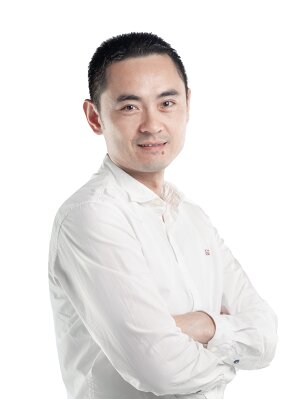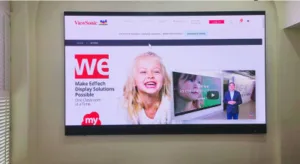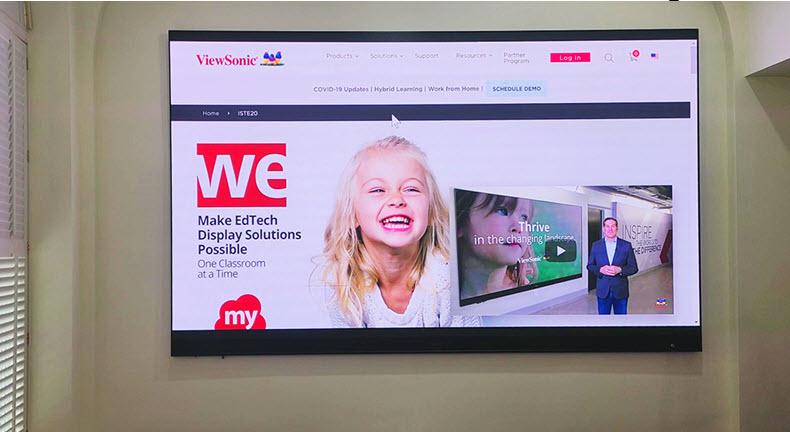There has been a trend from companies in the LED wall business to develop standalone ‘monolithic’ displays rather than the custom and modular approach that is traditional in that market. So it was interesting to hear the views from a firm that started from standalone displays rather than the modular business.

 We were able to catch up for an interview with Dean Tsai, General Manager of Projector & LED Display Business Unit at ViewSonic.
We were able to catch up for an interview with Dean Tsai, General Manager of Projector & LED Display Business Unit at ViewSonic.
Q There are lots of different terms used in the large direct view display market. How does ViewSonic see the different kinds of large format displays and video walls?
A LCDs are typically limited to around 100″ with a single panel and if you want to build video walls with them, there are a number of challenges. They have to be aligned and then calibrated to make sure that they all look the same. Straight ‘out of the box’ there can be variations in colour and brightness and those have to be corrected. They also age differently, so you have to be able to correct them and maintain them over time. Even when they are well adjusted and calibrated, the bezels between the different panels can be problematic. If a panel fails, it can be really difficult to just replace a single panel.
Direct LED displays do not have issues with the bezels and because they are fundamentally modular, they are much easier to design for custom shapes and sizes up to very large sizes. However, they can be expensive and again there can be challenges to match modules in colour and brightness. LED walls usually have to have special separate controllers. Again, the walls need to be maintained.
To get round these pain points, we have been developing our ‘All-In-One’ direct view LED displays that has the controller and power supply integrated and that means simple and quick installation and set up. The displays can also offer more brightness and wider colour than LCDs. We are supplying these displays in sizes above LCD at 108″ to 216″ diagonal.
The LEDs also have a very long lifetime with up to 100,000 hours possible.
Q I’m sure there are more things to take into account rather than just adding a surround to a number of LED tiles. Can you clarify those?
A For this type of display, it makes sense to move away from traditional LED structures and we are using Chip-on-Board (COB) LED Packaging to improve the resolution and durability as well as making the displays more moisture and dust proof. Traditional surface mount LEDs are very easy to damage, and the COB technology makes them more robust. COB LEDs can be mounted closer together to boost resolution. We also add integrated Harman Kardon speakers and can support resolutions up to 4K.
To make life easier for users we have a ‘solution kit’ that combines a display with a movable flight case and a motorised height-adjustable stand. That makes this kind of display ideal for rental businesses, exhibitions but any application where the ability to move the display makes the use more economic.
We are also looking at making the displays ‘foldable’ with a three fold design. That makes the set so much smaller to move around. It’s easier to get into an elevator and the smaller bulk makes shipping cheaper.
Q What kind of applications have you seen the All-in-One displays going into?
A We’ve seen a 163″ display go into the Georgia Military College boardroom to allow clear text and visuals even in high ambient light. In Munich, we have put in a 135″ display to minimize the time taken to set up new events in an architecture museum. The installation took only 10 minutes with two people. The ‘frameless on three sides’ format is also an attractive design option for our 216″ for large venues and public spaces.
We are also seeing that trend to higher resolutions with increasing interest in 4K solutions, especially from engineering and research institutions as well as luxury locations such as receptions, VIP rooms and high end home cinemas.
Q Are there features that you offer to make the usage more flexible?
A Yes. Although the expectation is that most users will want completely integrated displays, some people like to detach the control box to located it away from the display, so we have enabled that. We have also optimised the design to allow use in portrait mode (the thermal design has to be optimised for this) as in applications such as museums or retail, that mode can really make the display stand out visually. It can also be useful for showing social media posts and videos.
However, the priority has been to keep things simple to operate and maintain. For example, the motorised stand has 360 degree silent wheels to make movement easier and the height can be changed by up to 60cm using a simple motorised control. We also have wireless sharing for meetings and easier connection of mobile devices.
There are Picture in Picture (PIP) and Picture by Picture (PBP) modes for applications where multiple sources need to be visible.
The other factor is that we want to make sure that maintenance is easy. Even though they are the most reliable displays, LEDs can be damaged or fail, so the individual modules that make up the All-in-One displays can be replaced from the front of the display. We have special tools for that.
Q Where do you see LED-based LFDs going next?
A. We see a continuing trend to smaller pixel pitch and higher resolutions. At the moment, the displays could be described as miniLEDs, but microLEDs are under development and we see those arriving in the future. We see foldable screens as a significant development and better image quality will mean more use in applications that need photorealism, such as virtual movie production.
Thanks, Dean. I’m looking forward to seeing how the folding option is implemented – after discussions in the past with Panasonic about the challenges of the logistics of its 150″ PDP, I’m aware of the challenges of moving and installing anything of that size and above. Modular approaches can solve that but, typically, mean a lot of skilled work to ensure that the re-assembly is not visible to the eye. Sony did a lot of work in its most recent Crystal LED displays to minimise the time taken because of the costs involved. (BR)


